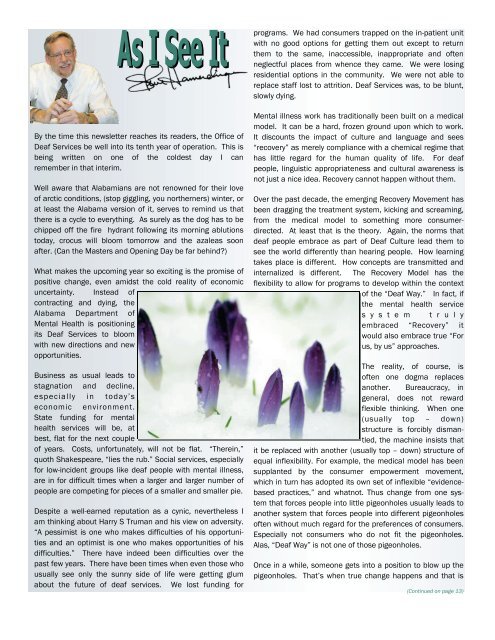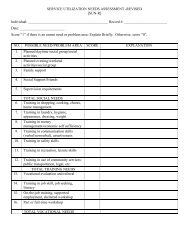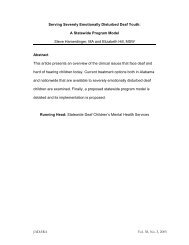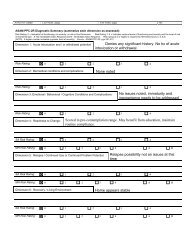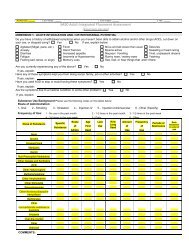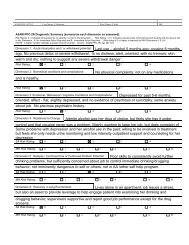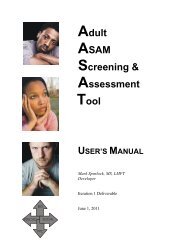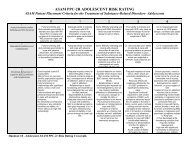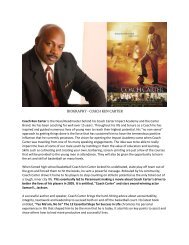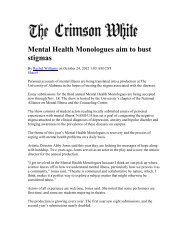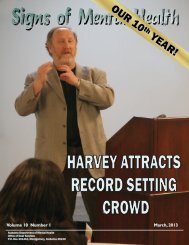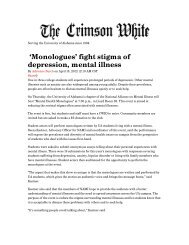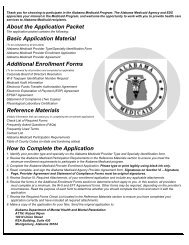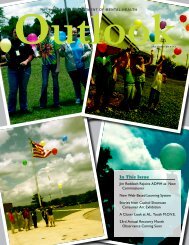Volume 8 Number 4 December, 2011 - Alabama Department of ...
Volume 8 Number 4 December, 2011 - Alabama Department of ...
Volume 8 Number 4 December, 2011 - Alabama Department of ...
Create successful ePaper yourself
Turn your PDF publications into a flip-book with our unique Google optimized e-Paper software.
programs. We had consumers trapped on the in-patient unit<br />
with no good options for getting them out except to return<br />
them to the same, inaccessible, inappropriate and <strong>of</strong>ten<br />
neglectful places from whence they came. We were losing<br />
residential options in the community. We were not able to<br />
replace staff lost to attrition. Deaf Services was, to be blunt,<br />
slowly dying.<br />
By the time this newsletter reaches its readers, the Office <strong>of</strong><br />
Deaf Services be well into its tenth year <strong>of</strong> operation. This is<br />
being written on one <strong>of</strong> the coldest day I can<br />
remember in that interim.<br />
Well aware that Alabamians are not renowned for their love<br />
<strong>of</strong> arctic conditions, (stop giggling, you northerners) winter, or<br />
at least the <strong>Alabama</strong> version <strong>of</strong> it, serves to remind us that<br />
there is a cycle to everything. As surely as the dog has to be<br />
chipped <strong>of</strong>f the fire hydrant following its morning ablutions<br />
today, crocus will bloom tomorrow and the azaleas soon<br />
after. (Can the Masters and Opening Day be far behind)<br />
What makes the upcoming year so exciting is the promise <strong>of</strong><br />
positive change, even amidst the cold reality <strong>of</strong> economic<br />
uncertainty. Instead <strong>of</strong><br />
contracting and dying, the<br />
<strong>Alabama</strong> <strong>Department</strong> <strong>of</strong><br />
Mental Health is positioning<br />
its Deaf Services to bloom<br />
with new directions and new<br />
opportunities.<br />
Business as usual leads to<br />
stagnation and decline,<br />
especially in today’s<br />
economic environment.<br />
State funding for mental<br />
health services will be, at<br />
best, flat for the next couple<br />
<strong>of</strong> years. Costs, unfortunately, will not be flat. “Therein,”<br />
quoth Shakespeare, “lies the rub.” Social services, especially<br />
for low-incident groups like deaf people with mental illness,<br />
are in for difficult times when a larger and larger number <strong>of</strong><br />
people are competing for pieces <strong>of</strong> a smaller and smaller pie.<br />
Despite a well-earned reputation as a cynic, nevertheless I<br />
am thinking about Harry S Truman and his view on adversity.<br />
“A pessimist is one who makes difficulties <strong>of</strong> his opportunities<br />
and an optimist is one who makes opportunities <strong>of</strong> his<br />
difficulties.” There have indeed been difficulties over the<br />
past few years. There have been times when even those who<br />
usually see only the sunny side <strong>of</strong> life were getting glum<br />
about the future <strong>of</strong> deaf services. We lost funding for<br />
Mental illness work has traditionally been built on a medical<br />
model. It can be a hard, frozen ground upon which to work.<br />
It discounts the impact <strong>of</strong> culture and language and sees<br />
“recovery” as merely compliance with a chemical regime that<br />
has little regard for the human quality <strong>of</strong> life. For deaf<br />
people, linguistic appropriateness and cultural awareness is<br />
not just a nice idea. Recovery cannot happen without them.<br />
Over the past decade, the emerging Recovery Movement has<br />
been dragging the treatment system, kicking and screaming,<br />
from the medical model to something more consumerdirected.<br />
At least that is the theory. Again, the norms that<br />
deaf people embrace as part <strong>of</strong> Deaf Culture lead them to<br />
see the world differently than hearing people. How learning<br />
takes place is different. How concepts are transmitted and<br />
internalized is different. The Recovery Model has the<br />
flexibility to allow for programs to develop within the context<br />
<strong>of</strong> the “Deaf Way.” In fact, if<br />
the mental health service<br />
s y s t e m t r u l y<br />
embraced “Recovery” it<br />
would also embrace true “For<br />
us, by us” approaches.<br />
The reality, <strong>of</strong> course, is<br />
<strong>of</strong>ten one dogma replaces<br />
another. Bureaucracy, in<br />
general, does not reward<br />
flexible thinking. When one<br />
(usually top – down)<br />
structure is forcibly dismantled,<br />
the machine insists that<br />
it be replaced with another (usually top – down) structure <strong>of</strong><br />
equal inflexibility. For example, the medical model has been<br />
supplanted by the consumer empowerment movement,<br />
which in turn has adopted its own set <strong>of</strong> inflexible “evidencebased<br />
practices,” and whatnot. Thus change from one system<br />
that forces people into little pigeonholes usually leads to<br />
another system that forces people into different pigeonholes<br />
<strong>of</strong>ten without much regard for the preferences <strong>of</strong> consumers.<br />
Especially not consumers who do not fit the pigeonholes.<br />
Alas, “Deaf Way” is not one <strong>of</strong> those pigeonholes.<br />
Once in a while, someone gets into a position to blow up the<br />
pigeonholes. That’s when true change happens and that is<br />
(Continued on page 13)


